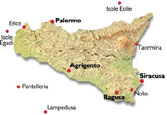|
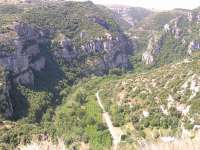 One of the very special hidden places of Sicily - a spectacular limestone gorge carved out by the rivers Anapo and Calcinara on their path through the deceptively gentle-seeming Monti Iblei to the west of Syracuse. Here was once a centre of the kingdom of the Sikels, one of the original Sicilian peoples. A good track runs along the floor of the gorge - it was (until the 1950s) a railway, part of a line which ran from Syracuse right up to Vizzini. There's a station - now a museum - and the original toilet block has been superbly restored! There are a few houses along the gorge - presumably the station was once for their benefit. There are also still a number of tunnels - some quite long, and very dark: a torch is recommended for the scotophobic. One of the very special hidden places of Sicily - a spectacular limestone gorge carved out by the rivers Anapo and Calcinara on their path through the deceptively gentle-seeming Monti Iblei to the west of Syracuse. Here was once a centre of the kingdom of the Sikels, one of the original Sicilian peoples. A good track runs along the floor of the gorge - it was (until the 1950s) a railway, part of a line which ran from Syracuse right up to Vizzini. There's a station - now a museum - and the original toilet block has been superbly restored! There are a few houses along the gorge - presumably the station was once for their benefit. There are also still a number of tunnels - some quite long, and very dark: a torch is recommended for the scotophobic.
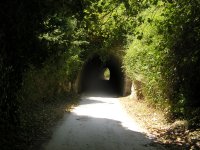 There are three possible approaches: one from the town of Sortino to the north west (they originally planned for the road to span the gorge and continue to Ferlà!) which entails a long and fairly gentle descent to the floor of the canyon (the river here is the Calcinara, which joins the Anapo a few hundred metres downstream) - there's a beautiful clear pool at the bottom [see below], in which it's possible (just) to swim. From there there is a long steady climb with fabulous views down to the Calcinara until you meet the Ferlà section of the road. An alternative is to take a steep path down from where the road out of Sortino comes to an end; this goes straight to the valley floor, where you can cross the Anapo by stepping stones, and join the old railway track. Or better, you can keep beside the river for the time being, and pass the confluence with the Calcinara - this is the wildest and most beautiful part of the gorge. There are three possible approaches: one from the town of Sortino to the north west (they originally planned for the road to span the gorge and continue to Ferlà!) which entails a long and fairly gentle descent to the floor of the canyon (the river here is the Calcinara, which joins the Anapo a few hundred metres downstream) - there's a beautiful clear pool at the bottom [see below], in which it's possible (just) to swim. From there there is a long steady climb with fabulous views down to the Calcinara until you meet the Ferlà section of the road. An alternative is to take a steep path down from where the road out of Sortino comes to an end; this goes straight to the valley floor, where you can cross the Anapo by stepping stones, and join the old railway track. Or better, you can keep beside the river for the time being, and pass the confluence with the Calcinara - this is the wildest and most beautiful part of the gorge.
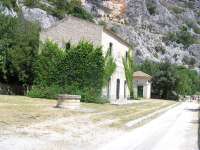 The old railway passes through lush vegetation (oak, ash, maple, poplar), orchards (citrus, almonds, the occasional persimmon: in late autumn with the leaves gone leaving just the fruit, the persimmons look like the golden apples of the Hesperides), and even a field with thoroughbred horses: this is the second way of getting access to Pantálica. It comes out on the Ferlà road, at the valley bottom, before the hairpins which lead up to the town. You can park here, and have an easy stroll along the track - or if you are really lazy, make use of the minibus service (free when I was there). The gorge teems with birdlife (eagles and ravens soar overhead), and even in November there are lizards and butterflies, and flowers - celandine and pale purple autumn crocus. The old railway passes through lush vegetation (oak, ash, maple, poplar), orchards (citrus, almonds, the occasional persimmon: in late autumn with the leaves gone leaving just the fruit, the persimmons look like the golden apples of the Hesperides), and even a field with thoroughbred horses: this is the second way of getting access to Pantálica. It comes out on the Ferlà road, at the valley bottom, before the hairpins which lead up to the town. You can park here, and have an easy stroll along the track - or if you are really lazy, make use of the minibus service (free when I was there). The gorge teems with birdlife (eagles and ravens soar overhead), and even in November there are lizards and butterflies, and flowers - celandine and pale purple autumn crocus.
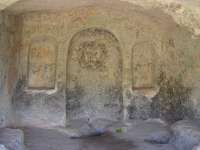 The most difficult, but most spectacular way to explore Pantálica is to continue uphill to Ferlà - a pleasant little town, with a once fine church; I bought some excellent fresh walnuts for next to nothing in the market there one November. A right turn takes you along a narrow winding road along the top of the gorge: after a few kilometres you'll reach a pleasant restaurant - the padrone has maps of the area - as well as excellent coffee. The road eventually ends at a precipice, from where you can see its hoped-for continuation on the far side to Sortino. Before you get there though, at roughly the highest point, there's a rough track leading to the so-called Anaktoron: possibly the sparse remains of the ancient capital of King Hyblon, the Sikel king who gave his name to Megara Hyblaea. You can park here, and follow various tracks which will lead you eventually to the railway track below. On your way you will pass numerous rock tombs: in prehistoric times (13th to 8th century BC) this was a vast Necroplis - over 5000 tombs perforate the limestone walls of the gorge. It was inhabited again in the Byzantine era, when refugees from Syracuse and elsewhere took shelter there - you will see signs to the Byzantine rock-church of S.Micidario, near which there are numerous cave-dwellings from the same period. The most difficult, but most spectacular way to explore Pantálica is to continue uphill to Ferlà - a pleasant little town, with a once fine church; I bought some excellent fresh walnuts for next to nothing in the market there one November. A right turn takes you along a narrow winding road along the top of the gorge: after a few kilometres you'll reach a pleasant restaurant - the padrone has maps of the area - as well as excellent coffee. The road eventually ends at a precipice, from where you can see its hoped-for continuation on the far side to Sortino. Before you get there though, at roughly the highest point, there's a rough track leading to the so-called Anaktoron: possibly the sparse remains of the ancient capital of King Hyblon, the Sikel king who gave his name to Megara Hyblaea. You can park here, and follow various tracks which will lead you eventually to the railway track below. On your way you will pass numerous rock tombs: in prehistoric times (13th to 8th century BC) this was a vast Necroplis - over 5000 tombs perforate the limestone walls of the gorge. It was inhabited again in the Byzantine era, when refugees from Syracuse and elsewhere took shelter there - you will see signs to the Byzantine rock-church of S.Micidario, near which there are numerous cave-dwellings from the same period.
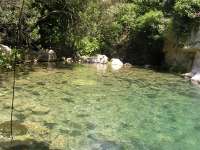
If you enjoyed the visit to Pantálica, there is a much deeper gorge near Avola Antica called Cava Grande del Cassabile.
|

